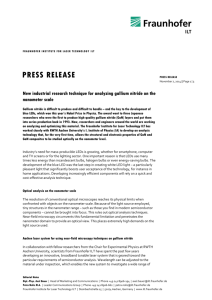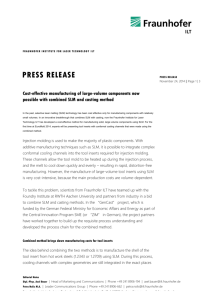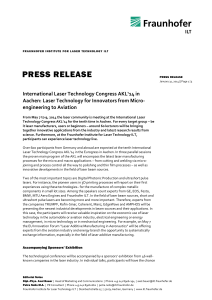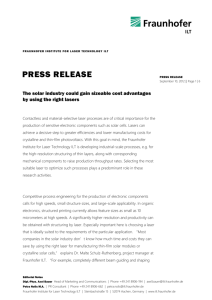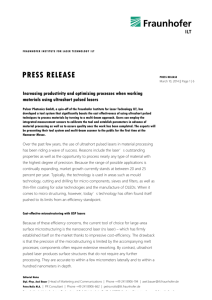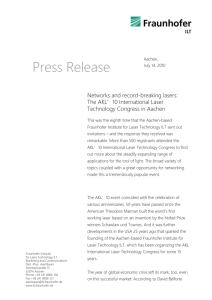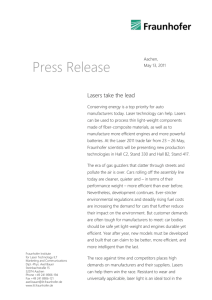DOCX 0.07 MB - Fraunhofer ILT
advertisement
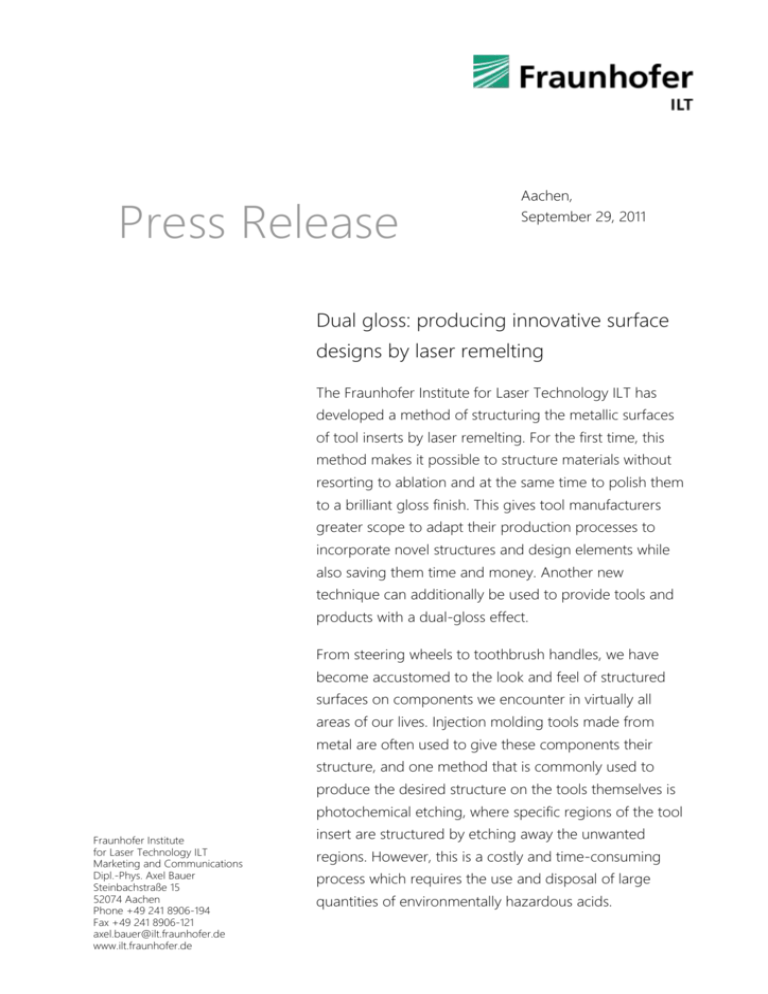
Press Release Aachen, September 29, 2011 Dual gloss: producing innovative surface designs by laser remelting The Fraunhofer Institute for Laser Technology ILT has developed a method of structuring the metallic surfaces of tool inserts by laser remelting. For the first time, this method makes it possible to structure materials without resorting to ablation and at the same time to polish them to a brilliant gloss finish. This gives tool manufacturers greater scope to adapt their production processes to incorporate novel structures and design elements while also saving them time and money. Another new technique can additionally be used to provide tools and products with a dual-gloss effect. From steering wheels to toothbrush handles, we have become accustomed to the look and feel of structured surfaces on components we encounter in virtually all areas of our lives. Injection molding tools made from metal are often used to give these components their structure, and one method that is commonly used to produce the desired structure on the tools themselves is photochemical etching, where specific regions of the tool Fraunhofer Institute for Laser Technology ILT Marketing and Communications Dipl.-Phys. Axel Bauer Steinbachstraße 15 52074 Aachen Phone +49 241 8906-194 Fax +49 241 8906-121 axel.bauer@ilt.fraunhofer.de www.ilt.fraunhofer.de insert are structured by etching away the unwanted regions. However, this is a costly and time-consuming process which requires the use and disposal of large quantities of environmentally hazardous acids. September 29, 2011 Page 2 A more environmentally-friendly alternative is the technique of laser structuring by ablation, which has been used successfully for more than ten years. This method can achieve ablation rates of 1-10 mm3/min in processes designed to create structures > 10 µm, but in many cases the workpiece subsequently requires further treatment to remove the melt residue which accumulates during ablation. In addition, the laser requires some ten passes to achieve a structure depth of 200 µm, which means that the laser-based structuring of large surfaces through ablation is generally not a cost-effective option for tool manufacturers. Remelting instead of ablation Fraunhofer ILT has now developed a method of structuring tools using laser remelting. The laser beam travels over the workpiece and the resulting heat input melts the metal surface. At the same time, the laser power is modulated in order to continuously change the size of the melt pool at defined points. »This modulation causes the material to be redistributed, creating mountains and valleys: half of the resulting structure lies Fraunhofer Institute for Laser Technology ILT Marketing and Communications Dipl.-Phys. Axel Bauer Steinbachstraße 15 52074 Aachen Phone +49 241 8906-194 Fax +49 241 8906-121 axel.bauer@ilt.fraunhofer.de www.ilt.fraunhofer.de above its initial level, while the other half lies below it,« says André Temmler, project manager at Fraunhofer ILT. Thanks to surface tension, when the uppermost layer of the molten material solidifies, it exhibits uniformly low roughness, and the surface is left with a brilliant polished September 29, 2011 Page 3 finish. Unlike laser structuring by ablation, the novelty of laser structuring by remelting is its ability to directly produce finished surfaces which do not require any postprocessing. For a structure depth of approximately 200 µm, this method can achieve processing rates of up to 75 mm2/min, enabling a volume redistribution rate of 15 mm³/min in a single pass. A further advantage of this new method is that it consumes less energy and fewer resources than conventional laser-based structuring by ablation. Less energy is required for melting than for sublimation, the process requires significantly fewer passes, and there is no loss of material. Depending on the material and batch size, these benefits can yield considerable time and cost savings for tool manufacturers. For flat surfaces and single-curved component geometries, the laser technique of structuring by remelting is already available for industrial use. Temmler and his team are now working on applying the technique to freeform surfaces. Dual-gloss effect by selective laser polishing Fraunhofer Institute for Laser Technology ILT Marketing and Communications Dipl.-Phys. Axel Bauer Steinbachstraße 15 52074 Aachen Phone +49 241 8906-194 Fax +49 241 8906-121 axel.bauer@ilt.fraunhofer.de www.ilt.fraunhofer.de In cases where an additional dual-gloss effect is required for end products such as decorative elements or an entire product surface, the first step is to apply a matt finish to the whole surface of the tool, which is generally achieved through blasting with glass beads or sand. Selected September 29, 2011 Page 4 regions are then remelted using a laser beam. These regions solidify from the melt with a polished finish – in other words, the selective laser polishing creates a contrast between the matt, untreated areas and the brilliant, laser-polished areas. Depending on the intensity of the dual gloss, this can even produce a 3D effect in which the polished points appear to protrude from the surface. One example of how selective laser polishing can be used is to provide structured tools designed to apply a leather grain structure to plastic components with a dualgloss effect which is then transferred to the end product during the molding process. For the first time, this selective polishing technique can now be applied on an industrial scale for both flat and freeform surfaces. Visitors to the joint Fraunhofer Booth C66 in Hall 11 at EuroMold 2011 will have the opportunity to see components produced with workpieces which were laser structured by remelting. Our experts will also be presenting a selection of sample objects molded in plastic by selectively laser-polished tools. Captions: Fraunhofer Institute for Laser Technology ILT Marketing and Communications Dipl.-Phys. Axel Bauer Steinbachstraße 15 52074 Aachen Phone +49 241 8906-194 Fax +49 241 8906-121 axel.bauer@ilt.fraunhofer.de www.ilt.fraunhofer.de Fig. 1: Surface with variable structures produced by laser remelting. Source: Fraunhofer Institute for Laser Technology ILT, September 29, 2011 Page 5 Aachen. Fig. 2: Dual gloss effect: molded plastic component produced by a selectively laser-polished tool insert. Source: Fraunhofer Institute for Laser Technology ILT, Aachen. Fraunhofer Institute for Laser Technology ILT Marketing and Communications Dipl.-Phys. Axel Bauer Steinbachstraße 15 52074 Aachen Phone +49 241 8906-194 Fax +49 241 8906-121 axel.bauer@ilt.fraunhofer.de www.ilt.fraunhofer.de September 29, 2011 Page 6 Your contacts at the Fraunhofer ILT Our experts are on hand to answer your questions: André Temmler Polishing Phone +49 241 8906-299 andre.temmler@ilt.fraunhofer.de Dr. Konrad Wissenbach Additive Manufacturing and Functional Layers Phone +49 241 8906-147 konrad.wissenbach@ilt.fraunhofer.de Fraunhofer Institute for Laser Technology ILT Steinbachstrasse 15 52074 Aachen Phone +49 241 8906-0 Fax +49 241 8906-121 www.ilt.fraunhofer.de Fraunhofer Institute for Laser Technology ILT Marketing and Communications Dipl.-Phys. Axel Bauer Steinbachstraße 15 52074 Aachen Phone +49 241 8906-194 Fax +49 241 8906-121 axel.bauer@ilt.fraunhofer.de www.ilt.fraunhofer.de
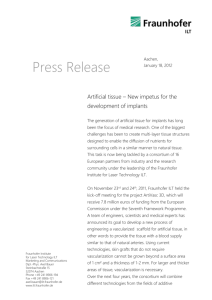
![LASHARE Press Release Project Start [ DOCX 0.29 MB ]](http://s3.studylib.net/store/data/006895368_2-c419881f96c28d1378c5ef51519b8fdb-300x300.png)
